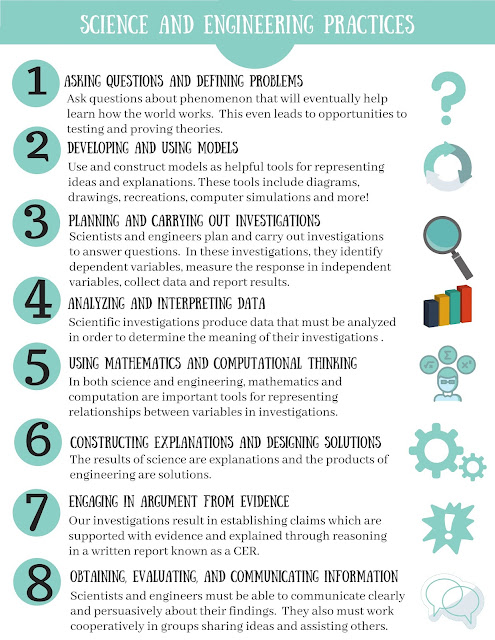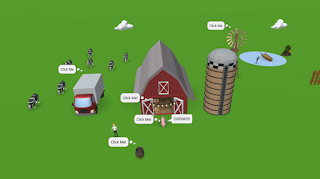As we started our year in Science with the Next Generation Science Standards for Middle School, I knew that we'd need some prep time familiarizing ourselves with the Science and Engineering practices as each standard is framed in a particular practice as we migrate through the year. To those unfamiliar, the SE practices are:
To start our year in sixth grade, I decided to PRACTICE each PRACTICE before practically applying them to our standards. That way the students have a good understanding of the process, procedures and expectations that correspond with each of the Next Generation Science standards.
Some of the practices have more of an engineering focus, and others relate better to Science. Paul Anderson does an excellent job of explaining these practices and I used his Bozeman Science video series here to glean a better understanding of each practice. After we worked on each practice, we then reviewed using this game and posters:
Science and Engineering Practice #2: Developing Models
As we consider the practice of developing models, it's important to note what was (and was not) intended to represent modeling in the new standards. The standards consider modeling to be external representations of mental concepts.
Models can be:
Models can be:
- diagrams
- three-dimensional physical structures
- computer simulations
- mathematical formulations
- analogies
It's important to note that modeling should be of SYSTEMS and PROCESSES not structures.
Some of our time modeling is spent making observations, models and diagrams. As such, we spent time learning how to make (and record) those observations in our interactive notebooks like scientists do.
 |
| https://www.teacherspayteachers.com/Product/Scientific-Drawing-Lesson-Plan-4767704 |
We also learned how to model using the Polar Bear Dice Game. The students were given a the Polar Bear Dice Game phenomenon to consider and were encouraged to model their initial theory about the phenomenon. As additional information was revealed to students, they had to test and evaluate their model and then revise it if necessary. This was a GREAT way to get them into the practice of modeling unfamiliar concepts and adding/revising them.
 |
| https://www.teacherspayteachers.com/Product/Science-and-Engineering-Practice-2-Developing-a-Model-5184763 |
Wipe Erase Boards
Other ways we've successfully modeled our investigations are on giant wipe boards. Often students work in groups to create (and explain) their discoveries.
Other ways we've successfully modeled our investigations are on giant wipe boards. Often students work in groups to create (and explain) their discoveries.
TECH TIP! One great tool that helps save information from wipeboards into your Drive are Rocketbook Beacons! Rocketbook Beacons allow you to capture, organize and broadcast important notes, diagrams, and big ideas on any whiteboard or wall surface..
Another tool helpful is Tinkercad. Tinkercad is a free, easy-to-use app for 3D design, electronics, and coding. We found Tinkercad great for modeling molecular structure:
Here's more on using Tinkercad in your classroom!
CoSpacesEDU
CoSpacesEDU
One tool that I've found very effective for three-dimensional modelling of systems is CoSpacesEDU. This virtual environment allows students to construct, design, evaluate, modify and demonstrate their learning in a 3D space. Here's an example of an Energy World that students created to model different forms of energy in real world settings.








